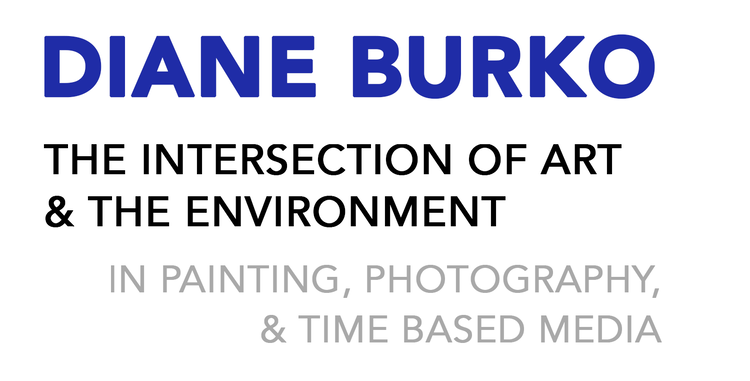DIANE BURKO: SEEING CLIMATE CHANGE x FITLER CLUB
Diane Burko’s practice is located at the intersection of art, science and the environment. Her work on climate change is informed by frequent collaborations with scientists, travels to endangered ecosystems around the globe, and committed activism. “I see myself as a subversive artist, creating compelling images which in turn inform the public of the dire threats facing our planet. My inclination to witness, translate, and communicate scientific information is expressed through paintings, photographs and time-based media. It’s how I personally and professionally counter climate doubt – it’s my way of entering into the public discourse with the goal of moving the viewer to reflect, reject fossil fuel dependency, and take responsible action.” - Burko
Diane Burko’s installation at 2400 Market (Installed in 2021) is supported by Fitler Club’s Artists in Residence Program.
To learn more about Artists in Residence, visit fitlerclub.com/art/artists-in-residence
Coral Quartet I-IV
Coral Quartet I-IV alludes to the four stages in the life-cycle of a coral reef ecosystem.
Coral Quartet I (top left) symbolizes how Caribbean coral looks when healthy. Coral Quartet II (top right) indicates increased stress with its high intensity colors - in a similar way to how leaves look in autumn. Coral Quartet III (bottom left) alludes to coral bleaching, which happens when temperature and acidity in the ocean increase. These conditions cause the live polyps to perish and the algae to disappear, leaving their calcium carbonate structures empty. Coral Quartet IV (bottom right) alludes to the way in which single cell organisms take over those structures, but are unable to sustain ocean life.
RESOURCES:
Coral reef ecosystem life cycle:
Coral reef basic information (from U.S. Environmental Protection Agency):
https://www.epa.gov/coral-reefs/basic-information-about-coral-reefs
Coral reef ecosystems (NOAA):
https://www.noaa.gov/education/resource-collections/marine-life/coral-reef-ecosystems
Comprehensive article on corals/coral reefs (Smithsonian):
https://ocean.si.edu/ocean-life/invertebrates/corals-and-coral-reefs
Arctic Melting
Arctic Melting represents the melting of glaciers in the Arctic Circle, which is advancing at a much more rapid pace than what was predicted. This dramatic development contributes to the rising of sea level and increased flooding world-wide.
This painting is located by the elevators.
RESOURCES:
Temperatures in parts of the Arctic hit 86.5 degrees Fahrenheit this week -- breaking several local records.
How long will the Arctic exist? (Guardian piece):
How Arctic change affects the rest of the globe:
https://public.wmo.int/en/media/news/glacier-melt-and-arctic-change-affects-globe
Why are glaciers and sea ice melting? (WWF):
https://www.worldwildlife.org/pages/why-are-glaciers-and-sea-ice-melting
Glacier Melting (National Geographic):
https://www.nationalgeographic.com/environment/article/big-thaw
Glacier Loss (Washington Post):
https://www.washingtonpost.com/climate-environment/2021/01/25/ice-melt-quickens-greenland-glaciers/
Petermann Heading South
Petermann Heading South (after NASA 2010-11), is based on a 2010 incident on the northwestern coast of Greenland, when part of an ice sheet broke off and drifted southward through the Labrador Sea breaking into two pieces as it passed Newfoundland. That piece of floating ice was four times the size of Manhattan and posed a potential hazard for shipping lanes and offshore oil rigs. Luckily it became grounded on the sea level off the coast.
This painting is located on the west pillar across the lobby
RESOURCES:
Petermann glacier research:
https://petermannsglacialhistory.wordpress.com/
Glacier loss (Washington Post):
https://www.washingtonpost.com/climate-environment/2021/01/25/ice-melt-quickens-greenland-glaciers/
Academic article on Petermann glacier, and its connections to the Atlantic/Arctic oceans:
Petermann glacier article (NASA Earth Observatory):
Images from same source:
https://earthobservatory.nasa.gov/images/7999/petermann-glacier-greenland
Greenland Burning
Greenland Burning, references unprecedented incidents of wildfires in 2017 and again in 2019. These fires are part of a dangerous cycle: Greenland’s permafrost melts due to global warming which exposes large amounts of peat soil, the exposed soil is susceptible to lightning sparks that often ignite these wildfires, and the increased frequency of these fires itself accelerates the melting of the permafrost layer, by depositing heat absorbing black carbon on the ice sheet. The vast Greenland ice sheet is melting at some of its fastest rates in the past 12,000 years. It could quadruple over the next 80 years if greenhouse gas emissions don’t decline dramatically in the coming decades
This painting is located on the east pillar across the lobby.
RESOURCES:
2019 Greenland wildfire (NASA Earth Observatory):
2019 Greenland wildfire article (Universe Today):
2017 Greenland wildfires (Forbes):
https://www.forbes.com/sites/ericmack/2017/08/10/greenland-wildfire-ice-sheet-climate/
2017 Greenland wildfire transport, deposition, and emission impacts (European Geosciences Union):
https://acp.copernicus.org/articles/19/1393/2019/




